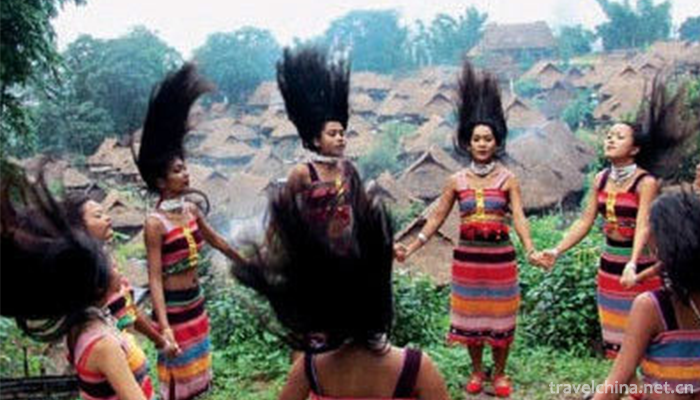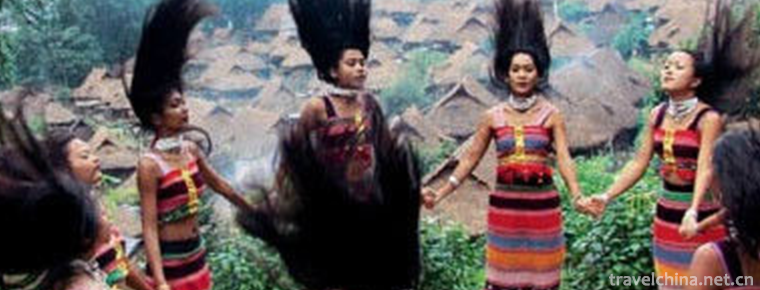Alpine Hand in Hand Dance
Alpine Hand in Hand Dance
"Hand-in-hand dance" is a kind of self-entertainment dance with the longest history and widespread spread spread among the folk dances of the mountain nationality. During the wedding and festival, they all dance hand in hand.
On June 7, 2008, Huaan County of Fujian Province declared "Alpine Hand-in-Hand Dance" which was approved by the State Council and listed in the second batch of national intangible cultural heritage list. Heritage serial number: 662 III-65.
historical origin
"Hand-in-hand dance" is a kind of self-entertainment dance with the longest history and widespread spread spread among the folk dances of the mountain nationality. During the wedding and festival, they all dance hand in hand. This kind of singing and dancing activity has existed in the Alpine nationality areas of Taiwan Province more than 1,000 years ago. According to Beishi Liuqiu Chuan, it is recorded that "singing with one foot, singing with one voice, all the people are in harmony, and the voice is rather sad. She gives her arm and dances with a wave of hands." This kind of situation, in which one person leads the singing, all people are in harmony and the ground is a festival, is basically consistent with the characteristics of the "hand-in-hand dance" of the present alpine people. In the Qing Dynasty "Taiwanese Students Familiar with Pictures", there is a picture of several people dressed in alpine costumes, dancing hand in hand. Its unique hand-holding method and step-around dance posture are also consistent with today's "hand-holding dance".
artistic characteristics
"Hand-in-Hand Dance" can be attended by both men and women. In daily entertainment, there are three or five people at a minimum and dozens of people at a large number. The grand festival can reach hundreds of people. When dancing, they form a circle or several circles, usually led by a singer and dancer. The lyrics include praise of ancestors, praise of heroes, congratulations on harvest, encouragement of production, singing of unity, and improvisation of love and hatred. There are many function words and linings in the lyrics, such as "Where to bend and where to yo", "Because is yo because of the sea". Sometimes a song uses function words from beginning to end, and some function words are added at the beginning or in the middle.
In the enthusiastic dance, some men will bend down excitedly to sweep the ground with pheasant feathers, and then get up and continue to jump forward. Their bodies will continue to flutter together and flutter up and down their feathers. The jubilant crowd, such as the tide of singing and dancing, will continue to roll over, and the unforgettable spectators may be involved in the sea of singing and dancing at any time.
"Hand-in-hand dance" mainly consists of "step up", "step down", "leg up" and "footstep" in all aspects. Due to the change of rhythm and combination, dance steps are quite rich. Men also have a large forward jump, squat, and then stand up and other more intense movements.
artistic form
There are two kinds:
One is that dancers naturally pull up their hands with each other, or connect their thumbs with each other, which is called "small hand";
The other is that the dancer and the two sides are separated by one person, crossing hands in front or behind one person beside him, and the arms are locked, which is called "big hand". Because the dancers hold hands, so the upper body movements are not much, but focus on the change of footsteps. Footworks include "left-right yo-yo-yo-yo", "step back", "one-foot left jump", "two-foot jump", "squat jump" and so on. Small Hand-in-Hand: The arms swing back and forth or up and down in different ranges, and the body leans forward and backward. The man in full dress bends forward deeply, making the long feathers on his hat brush across the ground and rise lightly, which is very distinctive. Large Hand-in-Hand: Most of the changes in the queue, or moving to both sides, or dense to the center of the circle, and then evacuated. When the number of participants is small, the singing and dancing is fresh; when the number of participants is large, the dancing scenes are spectacular and the singing is in full swing.


-
2.Mingyue Mountain
Mingyue Mountain: National tourist resorts, National Scenic spots, national AAAAA tourist attractions, National Forest parks, national geological parks, National Natural heritage, home of hot springs
Time 2018-12-08 -
3.Dongshan Cultural Garden
At the East Gate of Wu'an City, there is a beautiful landscape of lakes and mountains, with beautiful gardens scattered in pavilions and pavilions - Dongshan Cultural Park.
Time 2018-12-19 -
4.China Antique Car Museum
Located on the Houli Cultural Site, the Chinese Ancient Car Museum is the first most systematic and complete Museum in contemporary China, which integrates the Car and Horse Sites with the display of
Time 2018-12-22 -
5.Traditional Chinese Medicine Culture
Traditional Chinese medicine (TCM) is the oldest and most complete medical system in the world. It is not only a method of treating diseases, but also a complete philosophy of the universe and life.
Time 2019-04-22 -
6.Dai brocade weaving skills
Dai brocade weaving is one of the traditional handmade brocade weaving techniques in Xishuangbanna Dai Autonomous Prefecture, Yunnan Province, and one of the national intangible cultural heritage.
Time 2019-04-24 -
7.Lotus fall lian hua lao
Lotus Flower is a kind of traditional folk art with both rap and singing. The performers are mostly one person, self-talk and self-sing, self-play seven pieces of accompaniment.
Time 2019-05-13 -
8.Mongolian Horse Tool Making Skills
The Mongolian horse harness making technique is a handicraft in Horqin left-wing Houqi area of Inner Mongolia Autonomous Region. The production technology of horseback is accompanied by the "hors
Time 2019-06-05 -
9.Skills of Dry Lacquer and Ramie in Tiantai Mountains
As early as the Eastern Jin Dynasty, dry lacquer and ramie had been used in Tiantai folk. Through the continuous efforts of the substitute craftsmen, their skills gradually matured. In the mid-Tang Dy
Time 2019-06-21 -
10.Borneol Bridge
Luxian county is the "hometown of dragon culture" and "the hometown of Longqiao" in China. There are hundreds of ancient Longqiao bridges in the Ming and Qing Dynasties in Luxian County, which is the largest group of Longqiao in China and even in the world.
Time 2020-10-16 -
11.The origin of style of Chinese Cheongsam QiPao
The first one, represented by Zhou Xibao's the history of ancient Chinese costumes, believes that Qipao is directly developed from the robes of banner women in Qing Dynasty. However, some scholars believe that "although the cheongsam of the Republic of China
Time 2020-12-11 -
12.Dazhou climate
Dazhou city belongs to subtropical humid monsoon climate type. Due to the complex topography, regional climate differences are large. The low mountains, hills and river valleys with an altitude of 800 meters have mild climate, warm winter, early sprin
Time 2020-12-20